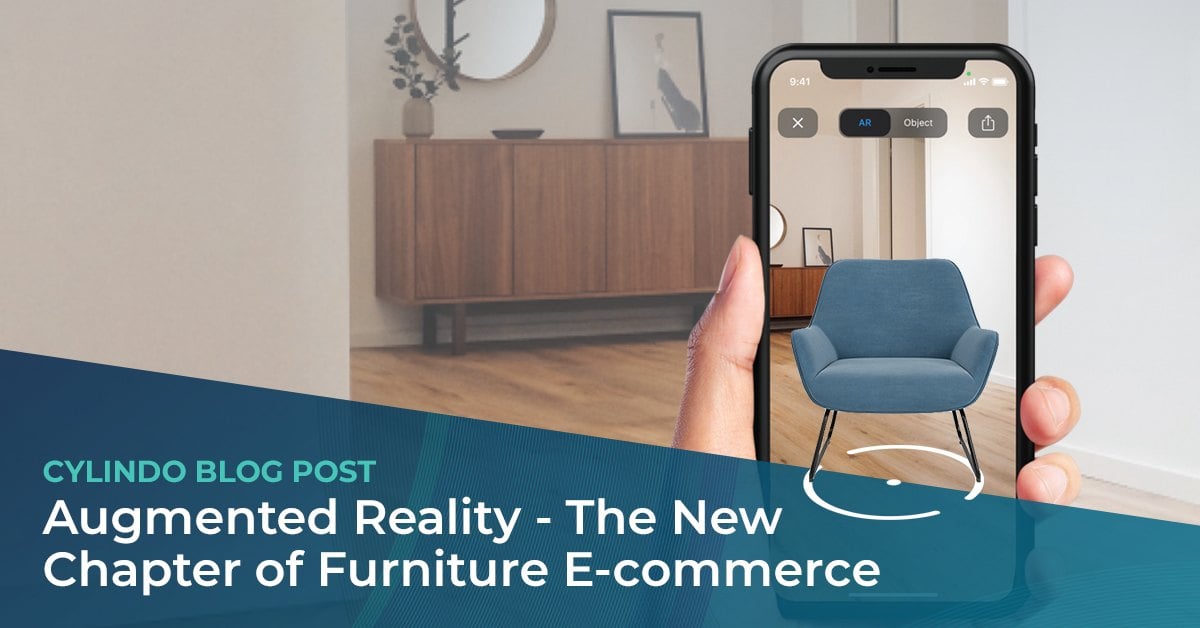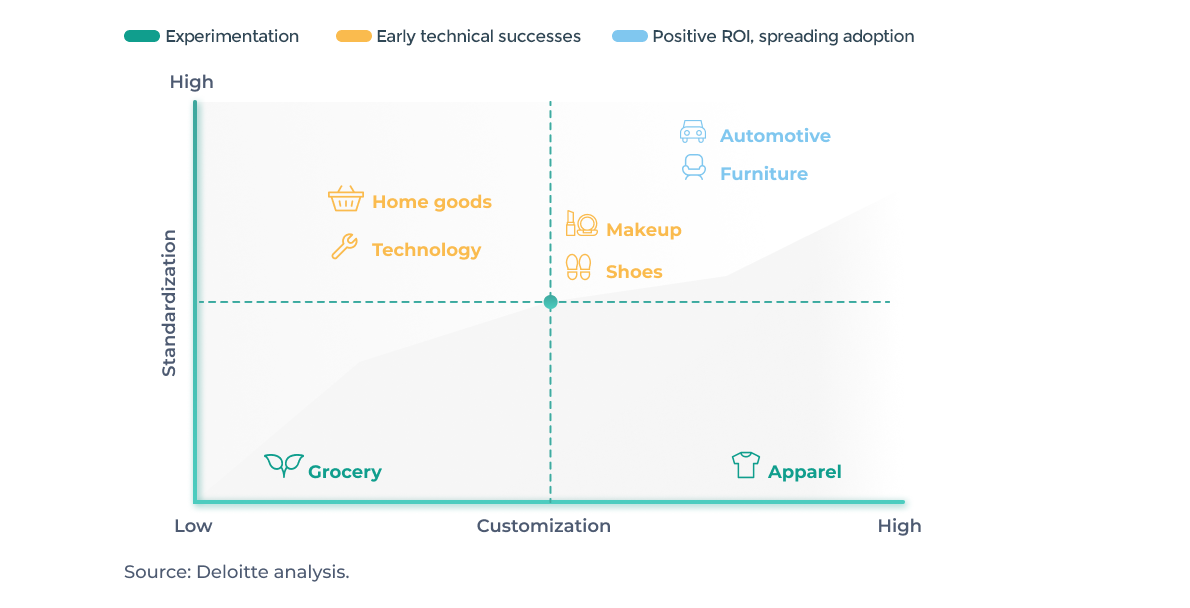Key Points:
- The Imperative for Omnichannel and Digital Transformation: Modern consumer demands require businesses to offer a seamless, engaging experience across all touchpoints (omnichannel approach). Success requires furniture companies to embrace digital technologies to meet climbing customer expectations and remain competitive against market entrants.
- Augmented Reality (AR) is the Essential Bridge for High-Value Visual Purchases: The furniture industry's visual nature makes AR a critical tool for conversion. AR allows customers to virtually place 3D models into their space, alleviating purchase anxiety, reducing returns, and driving significant business results. Consumers who engage with AR are up to eight times more likely to convert.
- Web-Native AR Ensures Maximum Customer Adoption and ROI: To maximize usage and minimize friction, web-native AR is the preferred technology. This approach eliminates the high barrier of downloading a dedicated mobile app, allowing customers to use the feature instantly via their web browser, which secures a higher adoption rate and a stronger return on investment (ROI).
The digital retail landscape is demanding immersive, personalized shopping experiences, placing the inherently visual furniture industry at a critical juncture.
Creating a truly engaging online experience is no longer optional, it is essential for survival and growth against tech-savvy competitors. Leading retailers are now leveraging technologies to gain a competitive advantage.
Chief among these is Augmented Reality (AR), which allows customers to virtually place high-value items like sofas and chairs directly into their homes. This crucial capability is redefining the customer journey, eliminating purchase hesitation, and accelerating the transition toward a future where digital and physical retail seamlessly converge.
The New Chapter of Furniture E-commerce
The furniture industry, an inherently visual sector, has always been subject to transformation via new technologies. Today, however, creating a highly engaging online shopping experience is a definitive must. As more tech-savvy furniture players enter the market, customer expectations for visualization and self-service climb even higher. Retailers are actively leveraging digital technologies to drive new levels of customer engagement and competitive advantage.
One area that holds immense promise for furniture brands is Augmented Reality (AR).
AR allows customers to insert virtual objects, such as sofas, tables, and chairs, into their actual homes and immediately see how the piece of furniture would look and fit. This capability lets customers virtually “try out” furniture, removing significant friction and eliminating the fear of making a costly, inappropriate purchase.
AR is rapidly moving from novelty to mainstream utility. According to the Snap Consumer AR Global Report by Deloitte and Snap, by 2025, nearly 75% of the global population and almost all smartphone users will be frequent AR users. This momentum extends directly into commerce, with 100 million consumers already shopping with AR online and in-stores.
Why is AR so critical for the furniture industry specifically?
Furniture represents a significant investment, and customers welcome every effort to bridge the spatial gap between the online screen and the physical home environment. More than 60% of consumers actively want to shop for furniture with AR.
Furthermore, furniture is considered an ideal category for augmented shopping because it involves highly standardized product sets with high opportunities for customization, leading to a strong return on investment (ROI) and widespread adoption potential.
Web-Native vs. AR App: Choosing the Right Technology
Businesses eager to adopt AR must decide between web-native AR and dedicated mobile applications. Choosing the right technology hinges on maximizing adoption rate and realizing tangible ROI.
-
App-based AR solutions require users to download a mobile application before they can experience the AR feature.
-
Web-native AR solutions allow customers to instantly place 3D models of selected products in the real world directly from a mobile web browser, without downloading an app.
The human brain is hardwired to follow the path of least resistance. Since furniture is not a frequently bought item, consumers are unlikely to bother downloading a dedicated AR app. This friction significantly lowers the adoption rate.
With billions of smartphone users worldwide, mobile is an integral part of the way consumers shop. Leveraging the devices already in their pockets, web-native AR is proving to be the superior choice for fueling business growth. Data confirms this: customers who engage with AR are up to eight times more likely to convert than those who do not use the feature.

As Julie Shulman, Director of Product Management at Interior Define, states: "We understand that our customers are busy and do a lot of their shopping while on the go. Offering web-native AR means our customers can easily visualize our products without the barrier of leaving our site to go to the App Store and download our mobile app.”
Expert roundup: Augmented reality - redefining the future of furniture shopping
To further understand the modern furniture landscape and the implications of augmented reality on the industry, we spoke to experts about the impact of AR on furniture e-commerce.
1. How important is augmented reality in the furniture shopping journey?

“Our goal is to make furniture shopping easier than ever—and now we have augmented reality as another tool in our arsenal. With AR, you can see how a new sofa would look in your living room before you buy it – or even try out different colors and textures on an item before committing. You can also use AR to get a sense of scale when considering large items like sofas or dining tables. It’s a game-changer for any retailer looking to engage with customers and increase sales.“
- Ash Mehta, Head of Digital & E-commerce at Plush

“Augmented reality finds a valuable use case in the furniture industry. These are complex objects that can be difficult for an end consumer to picture in their space. The use of mood boards, renderings, photoshops in design planning all illustrate this challenge. The interplay of different environmental factors can make a significant difference in what is, in the end-consumers eyes, a “good” purchase or a “bad” purchase. We have seen in customer surveys that AR is referenced as a common reason for purchase completion.“
- Dan Gange, Director of E-Commerce at at EQ3
2. What factors played a central role in your decision to use web-native AR and not traditional AR apps?

“If you're a high-volume/high-frequency brand, there may be some reason to go with a standalone app. For anyone else, i.e., most furniture brands, it makes no sense whatsoever to have a standalone app. The barriers for the customer are much too high, notwithstanding the development and maintenance costs.“
- Simon Peschcke-Køedt, CMO at Sofacompany

“Our analysis determined that web-native was the clear path forward. First, an app adds a friction point to the consumer experience in using AR technology. Second, EQ3 does not have a dedicated app to leverage. It would be expensive to get a platform to even leverage the feature, and then there would be ongoing upkeep. Perhaps if we had an existing app with a large user base, it would be less of a blocker, but that would still only allow us to expose a portion of our online customer base. EQ3 is able to leverage Cylindo’s web-native implementation along with a QR code implementation not just for mobile users but desktop as well. This allows our entire e-commerce customer base access to AR in one or two steps.“
- Dan Gange, Director of E-Commerce at at EQ3
Find out how EQ3 increased online conversion and AOV with webAR
3. How will augmented reality change the future of the furniture industry?

“The COVID-19 pandemic has taught us to be more digital and less dependent on the physical stores as a part of our purchasing journey. In that shift, AR will, in my opinion, be a key element to help transition from a fully analog to a mixed digital/analog customer journey.“
- Simon Peschcke-Køedt, CMO at Sofacompany

“Augmented reality is the next big thing in furniture. It's a game-changer for both consumers and retailers alike. Imagine seeing your sofa come to life on screen before you buy it, with just a few clicks on your phone. AR will become an essential part of the customer journey, so it's a must-have feature for any furniture retailer.“
- Ash Mehta, Head of Digital & E-commerce at Plush
Look into the future
Making it easy for customers to use AR with no app needed will positively influence the adoption rate and solidify its place in the omnichannel strategy. Retailers gain a powerful tool that perfectly complements a showroom visit, and customers receive the exact amount of visual information needed to make confident, informed purchasing decisions.
As we continue to see increased usage of AR in everyday life, the ability to access AR instantly without the need to install an app will become imperative for winning the digital consumer.
Ready to Lead the AR Revolution?
Augmented Reality is no longer a futuristic concept—it is the present-day tool driving superior conversion rates and essential omnichannel engagement in furniture e-commerce.
Don't let friction hinder your digital growth. Learn exactly how to implement web-native AR to elevate your customer journey and see an immediate impact on your bottom line.
Download our free ebook — Augmented Reality - The New Chapter of Furniture E-commerce.





